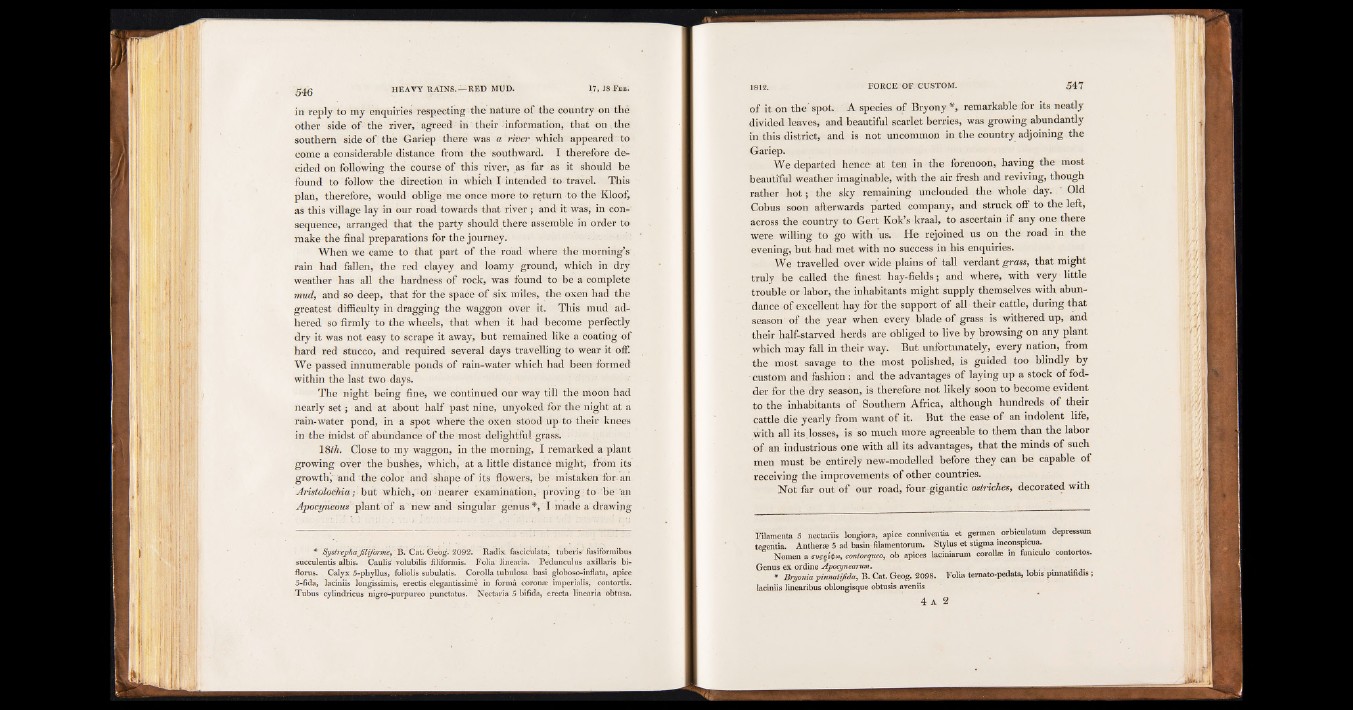
in reply to my enquiries respecting .the nature of the country on thè
other side of thè river, agreed in their information, that on thé
southern side of the Gariep there was a river which appeared to
come a considerable distance from the southward. I therefore decided
on following the course of this river, as far as it should be
found to follow the direction in which I intended to travel. This
plan, therefore, would oblige me once more to return to the Kloof,
as this village lay in our road towards that river ; and it was, in consequence,
arranged that the party should there assemble in order to
make the final preparations for the journey.
When we came to that part of the road where the morning’s
rain had fallen, the red clayey and loamy ground, which in dry
weather has all the hardness of rock, was found to be a complete
mud, and so deep, that for the space of six miles, the oxen had the
greatest difficulty in dragging the waggon over it. This mud adhered
so firmly to the wheels, that when it had become perfectly
dry it was not easy to scrapé it away, but remained like a coating of
hard red stucco, and required several days travelling to wear it off.
We passed innumerable ponds of rain-water which had been formed
within the last two days.
The night being fine, we continued our way till the moon had
nearly set ; and at about half past nine, unyoked for the night at a
rain-water pond, in a spot where the Oxen stood up to their knees
in the midst of abundance of the most delightful grass.
ISM. Close to my waggon, in the morning, I remarked a plant
growing over the bushes, which, at a little distancé might, from its
growth, and the color and shape of its flowers, be mistaken for an
Aristolochia ; but which, on nearer examination, proving: to be an
Apocyneòus plant of a new and singular genus *, I madè a drawing
* Systrepliajilifoi'me, B. Cat; Gebg.' 2092. Radix fasciculate, tuberis' fusiformibus
succulentis albis. Caulis volubilis filiformis. Folia linearia. Pedunculus axillaris bi-
florus. Calyx 5-phyllus, foliolis subulatis. Corolla tubulosa basi globoso-inflata, apice
5-fida, laciniis longissimis, erectis elegantissime in forma coronæ imperialis, contorti«.
Tubus cylindricus nigro-purpureo punctatus. Nectoria 5 bifida, erecta linearia òbtusa.
of it on the spot. A species of Bryony *, remarkable for its neatly
divided leaves, and beautiful scarlet berries, was growing abundantly
in this district, and is not uncommon in the country adjoining the
Gariep.
We departed hence at ten in the forenoon, having the most
beautiful weather imaginable, with the air fresh and reviving, though
rather h o t; the sky remaining unclouded the whole day. ." Old
Cobus soon afterwards parted company, and struck off to the left,
across the country to Gert Kok’s kraal, to ascertain if any one there
were willing to go with us. He rejoined us on the road in the
evening, but had met with no success in his enquiries.
We travelled over wide plains of tall verdant grass, that might
truly be called the finest hay-fields; and where, with very little
trouble or labor, the inhabitants might supply themselves with abundance
of excellent hay for the support of all their cattle, during that
season of the year when every blade of grass is withered up, and
their half-starved herds are obliged to live by browsing on any plant
which may fall in their way. But unfortunately, every nation, from
the most savage to the most polished, is guided too blindly by
custom and fashion: and the advantages of laying up a stock of fodder
for the dry season, is therefore not likely soon to become evident
to the inhabitants of Southern Africa, although hundreds of their
cattle die yearly from want of it. But the ease of an indolent life,
with all its,losses, is so much more agreeable to them than the labor
of an industrious one with all its advantages, that the minds of such
men must be entirely new-modelled before they can be capable of
receiving the improvements of other countries.
Not far out of our road, four gigantic ostriches, decorated with
Filamenta 5 nectariis longiora, apice conniventia et gennen orbiculatum depressum
tegentia. Antberae 5 ad basin filamentorum. Stylus et stigma inconspicua.
Nomen a ovrgi<|>», cmtorqueo, ob apices laciniarum corolla! in fiimculo contortos.
Genus ex ordine Apocynearum. , ; . .
» Bryonia pinnatifida, B. Cat. Geog. 2098. Folia temato-pedata, lobis pmnatifidis;
laciniis linearibus oblongisque obtusis aveniis